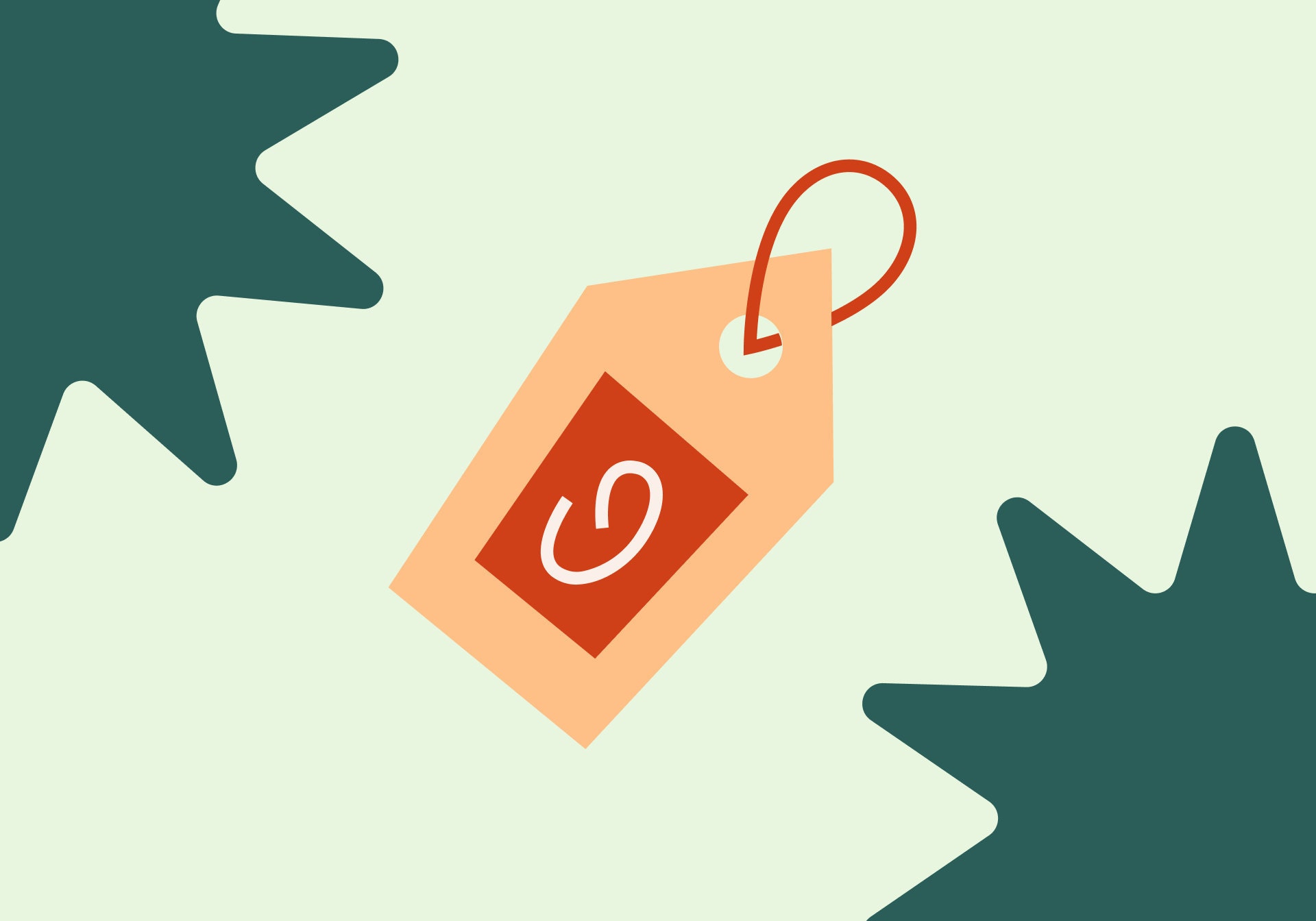Creating a pricing strategy is fundamental to the viability of every business. Prices that are too low or too high can have a variety of implications, with the potential to impact day-to-day sales as well as long-term growth. And as you might expect, price is one of the most important factors for shoppers when they’re deciding whether or not to make a purchase.
Many costs go into making a single finished product, including all of the expenses incurred during creation, sale, and dispatch. Getting a grasp on those costs - along with your desired profit - will help you determine your base retail price. Then, experimentation and market research will help you refine your approach over time, whether that’s reviewing your profit margins, tapping into proven marketing techniques (like advertising, sales, and coupons), or implementing tiered product offerings.
Read on for an introduction to common pricing considerations to help you grow your business while protecting your bottom line - or jump to a section here:
- Track expenses and income
- Try popular pricing formulas
- Set goals for growth
- Test the market and building a customer base
Establishing a system for tracking expenses and income
No matter what kind of business you run, it’s important to have an accurate understanding of your shop’s financial health. Keeping track of your expenses helps you make informed decisions and avoid surprises, like an unexpectedly large tax bill or unnecessary debt. Understanding the cost of the materials, time, labour, and overhead (business expenses that are not tied to a specific item, like growth marketing costs or studio rent) that go into creating and selling your inventory is foundational to the pricing process.
Pro tip: QuickBooks accounting software can help you keep track of your business expenses and income by importing up to 18 months of your Etsy shop data. Plus, Etsy Sellers save 50% off their first 3 months. Terms apply.
Ready to build an effective system? To get started, read more about tracking your business expenses and claiming deductions.
Two popular approaches to pricing
Finding the elusive pricing sweet spot isn't easy. Remember, your prices will evolve along with your business. To help, here we guide you through two complementary approaches. This exercise is all about trial and error - a space to experiment, observe, and learn what works best for your shop’s unique situation.
To get started, open our How to Price Your Listings worksheet, create a copy for yourself, and follow along from top to bottom to play around with your prices - no accountant skills required. Select one of your items to work with and get ready for some number crunching!
The top-down approach
Using this approach, you’ll use the cost of the materials, time, labour and overhead expenses to determine a base price for your item. Start with numbers that reflect what you currently spend. Then, consider what you might change to improve your bottom line.
1. Start with your materials
Make note of the materials you use to make each item and how much you spend on them, for every item. If you sell vintage items or craft supplies, note the cost of the item when you purchased it. If you offer free delivery, that cost can also be considered as a by-item material expense, or more broadly within your overhead costs. If you set up a free delivery guarantee in your shop, you can choose to adjust the prices of your items to recover postage costs. Remember, how you determine and set prices for your shop is solely your decision.
Experiment: Eliminate one material to see how that changes your costs. Then, see what happens when you decrease the individual costs of your materials. If you could purchase supplies in bulk or through a wholesale account, how would that affect costs?
For more tips on how to price your postage competitively, read about how to create a competitive delivery strategy.
2. Account for overhead
Make a list of any business expenses that are not tied to a specific item. For example, you may rent studio space, purchase equipment or buy petrol to drive to the supply store. Consider other expenses associated with running your business, including growth marketing costs, like Etsy Ads, sales and discounts, or paid social media promotion.You may also factor in applicable taxes and Etsy fees. Document all of these costs, then divide them by the number of items you have or plan to produce this year. That will give you an estimated overhead cost per item.
Experiment: Change the number of items produced per year or eliminate an overhead expenditure you could do without.
3. Cover your labour
It takes time to produce, package, and dispatch your items. Once you understand your costs, decide on your target profit margin and use that to estimate a sustainable list price. Consider your production process task by task. All in all, how many hours does it take to prepare this product for sale? What should you pay yourself for all that you do? That's the approach favoured by Hana Brewster, owner of Quiet Clementine, an Etsy shop that sells personalised home goods and celebratory items. Hana, who creates her products from home in Little Rock, Arkansas, suggests figuring out how much you would make at a typical day job. Keep in mind that you may be the only one doing every task involved with running your business, including production, packaging, delivery, editing photos, and answering emails. "Just because you have fun with your business”, Hana says, “doesn’t mean that you shouldn’t pay yourself fairly.”
Much like handmade items, vintage pieces require an outpouring of energy to prepare for listing, like cleaning, steaming, styling, photographing, and sourcing. Be sure to account for all this effort when calculating your labour costs.
Experiment: Eliminate a task or decrease the amount of time one step in your processes might take. Try different hourly wages. Can you make your processes more efficient by coupling similar tasks? Should you pay yourself more?
The bottom-up approach
You now have a good picture of what you’re currently spending. But does this mean your target customer would be willing to pay that amount, or that your pricing properly accounts for the value of your item? Not necessarily. That brings us to a second method of calculating price.
In the bottom-up approach, you’ll use research and testing to determine a price you think is right and then figure out how much you’d ideally spend on each part of the process so you can better reach this pricing goal. This approach is also popular with new sellers, since it’s a great way to test the waters and learn as you go.
Follow these two steps to figure out an ideal price:
1. Research the market
Prices: Consider where your products exist in the wider ecosystem of items available on Etsy and online. How do your prices compare? Do some research to see what similar items are selling for and make sure your price feels competitive while remaining profitable for you.
That doesn’t mean your item needs to be the cheapest option to attract customers. Higher rates can also appeal to shoppers, since a more premium price tag can signify made-to-last quality. Remember, items from a big-box shop don’t have the added value of a personally handled, one-of-a-kind piece. These retailers’ prices can provide a point of reference, but they aren’t likely your direct competitors. Maybe your item involves higher-quality materials, better craftsmanship, or a unique design. In your listing, be sure to highlight the features that make your item special and worth the price.
Delivery: In addition to an item’s price, shoppers may factor in postage prices when deciding whether (or not) to make a purchase. A shopper who loved your listing when they first came upon it, for example, could be deterred by expensive postage. Rather than displaying a listing price and a postage price that must be added together, offering free delivery and displaying a single “checkout price” to buyers upfront can not only convey the value of your items and appeal to their competitive delivery expectations - it can also ensure there are no surprises when they go to checkout.
Note: Etsy’s free delivery tool is currently only available for sellers who sell to US-based buyers.
Read more about how to create a competitive delivery strategy.
2. Determine your target audience
What you are willing and able to pay for a product may differ vastly from your target market’s budget. In other words: You’re not necessarily the target audience for your own product! Your customers may have different discretionary spending habits, and the concept of affordability is totally relative.
So, aim to get a clear picture of the type of folks who buy your items and what occasion they're purchasing for. For example, Olivier Gratton-Gagnė, who sells detailed map prints in his Montréal-based shop iLikeMaps, knows that his maps are often used as gifts for family members and friends. 'In that context', he says, 'I don’t hesitate to ask for $20 to $135 for a print that costs much less in materials, because those prices make sense for a thoughtful gift for someone you love.'
Shoppers also compare prices when looking at search results, so your listing price can also affect whether or not a buyer clicks on your listing. Shoppers may have a specific price point in mind before they even start their search. Consider introducing tiered product lines to both appeal to buyers with varying budgets and encourage multi-item orders.
Meeting in the middle
Using both of these approaches, it’s very possible that your actual and ideal prices will look quite different. That’s totally okay. This is your chance to figure out why! Use the information you've gathered to determine the right levers to pull and make adjustments to your business: Do you need to use less-expensive or fewer raw materials? Do you have to increase your efficiency or cut out tasks? Once you’ve established your shop, would the customers in your target audience be willing to pay more than the prices you started out with?
Remember, your prices are a continuous work in progress. Whenever something changes in your shop or the greater business ecosystem, it’s important to re-evaluate your approach. We’ll talk about this in more detail in the section about allowing for experimentation.
Calculating gross profit margins
Keeping track of your expenses also makes it easier to calculate your gross profit marginstrong text for each item. To determine your gross profit margin, subtract all of the expenses that go into creating a product (cost of goods) from the sale price. Divide that number by the sale price (revenue) and multiply by 100 to generate gross profit margin as a percentage.
Here’s the formula: (Revenue - Cost of goods) / Revenue = Gross profit margin
Having a clear sense of your gross profit margin can help power a number of your business decisions. Make a copy of this profit margin and pricing worksheet to get started with an example.
Profit margins vary widely by industry and many other factors. It’s common for a new business to have a lower profit margin as they’re starting out and spending more on customer acquisition (often through advertising and discounts), and then to see an increase in profit margin as they grow.
Allowing for experimentation
Remember, the prices you start out with aren’t set in stone. You can adjust your prices at any time, and buyers expect that prices will fluctuate over time.
There are many internal and external factors that might influence price changes. For example, if inflation is contributing to an increased cost of the materials you use to make, package, and sell your items, you may decide to adjust your base price to maintain your own profit margin. In contrast, discounting inventory can be a strategic approach depending on your goals, whether, for example, you’re looking to clear out seasonal inventory or appeal to new buyers.
Once you land on a price that you think makes sense, seek unbiased feedback from fellow business owners and shoppers. You can also set varying prices for similar items in your shop to see how well they sell – a process known as an A/B test.
Have a unique item that’s hard to price? You can choose to receive price offers from buyers on select listings, giving you more data points to help you find your pricing sweet spot with your shoppers while still setting your maximum discount. Learn more about how to let buyers make offers on your listings.
Setting goals for growth
When your base price allows for a healthy profit margin, you can then use growth marketing tools to accomplish additional objectives - like acquiring new customers, increasing average order value, or increasing order frequency.
Factoring growth marketing techniques - like discounting, sales events, and advertising - into your pricing strategy early on makes it easier to understand the impact on both sides of the transaction: in how you set your base price, as well as how a marketing campaign impacts your average order value, sales volume, and overall revenue.
If your business is just getting off the ground, breaking even might feel like a great place to start. Or, maybe you’ve been in business for a while and you're re-evaluating your pricing structure. Think about your shop’s scope and where you’d like to be by the end of the year (or another specific point in time). It’s helpful to price for the future, not only the present.
Find out how to write a creative business plan in under an hour for a basic framework to get started.
Testing the market and building a customer base
When you drop an order in the mail, you leave a little piece of yourself in the package. Putting a price on something close to your heart can be a vulnerable and humbling experience! If you’re just starting your shop, consider this common approach:
-
Consider aiming for a lower profit margin, if you’re just getting started. While you’re setting out to make your first few sales and build your reputation as a brand with customer reviews, this strategy can be especially helpful. As mentioned in the calculating gross profit margins section, it’s common for a new business to have a lower profit margin when they’re starting out and then to see an increase in profit margin as they grow.
-
Embrace experimentation and monitor your performance. Experimentation and continued testing are key to refining your prices over time.
- Adjust over time to achieve your business goals and price for profit. As you learn more about your customer base and target market, don’t be afraid to re-examine your prices and add varied price points to your product lines. After all, just like your shop as a whole, prices are a perpetual work-in-progress.
Note: As an Etsy seller, pricing is at your sole discretion. This means that you are responsible for making your own pricing decisions and are free to set prices as you wish. That said, remember there are also legal considerations to be aware of around pricing and discounting. Sellers cannot mislead consumers on discounted prices. The original price must be a true price that was in practice for a substantial amount of time, so, for example, you can’t artificially increase a price and cut it down just to make it look like you’re running a sale.
Return to the Ultimate Guide to Pricing
 Words by Etsy Staff
Words by Etsy Staff
Etsy staff writers and contributing editors.




